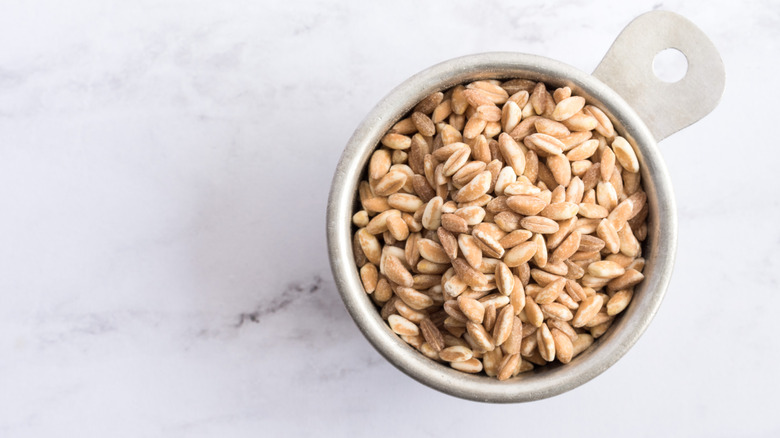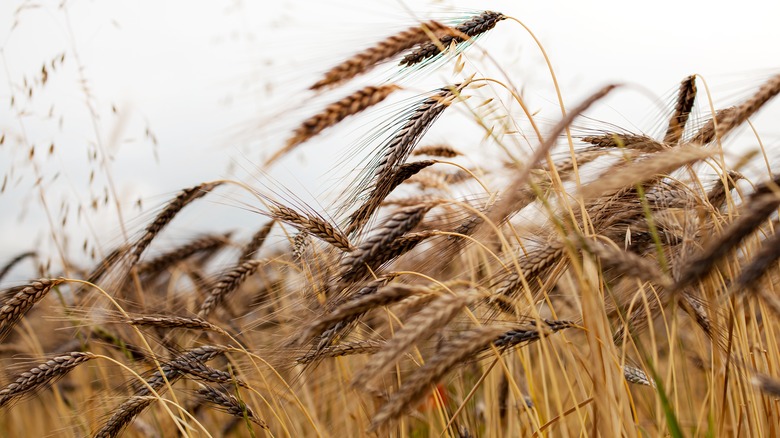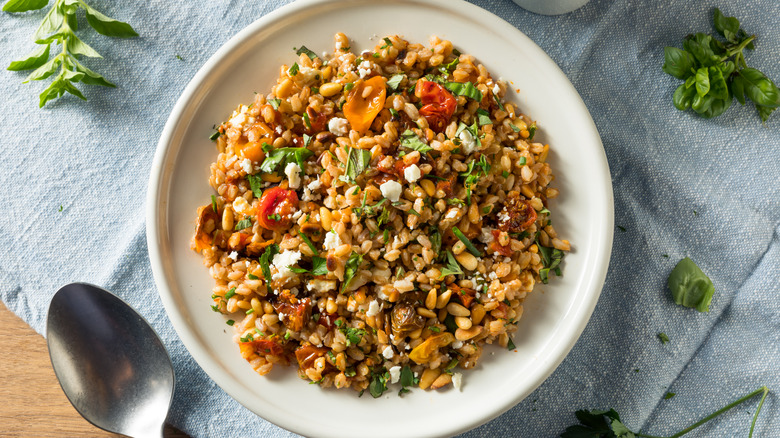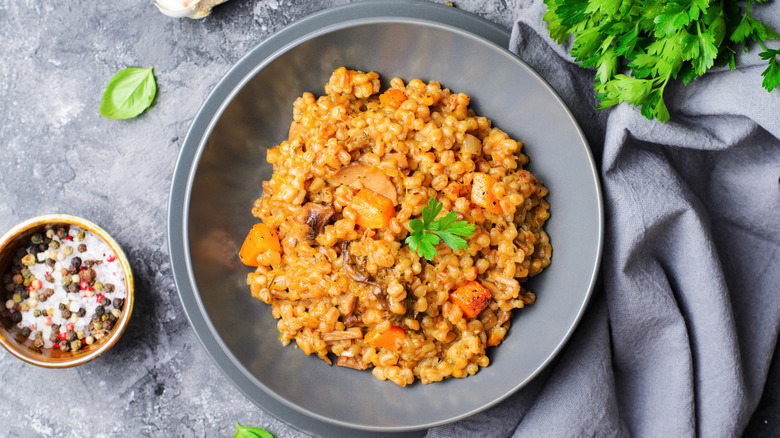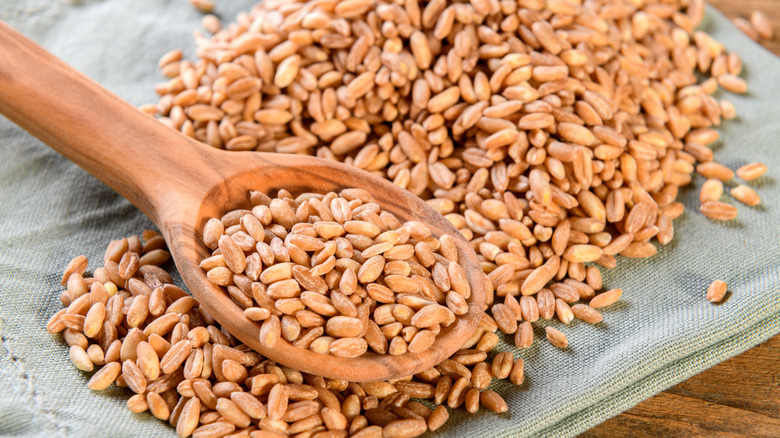What Farro Really Is And How To Cook It
We may receive a commission on purchases made from links.
Ancient grains are making a big comeback — and for many good reasons. Not only are they delicious, but they're also nutritious and helpful during food shortages. Of all the types, few are more versatile — and storied — than farro. Consumed by Egyptian pharaohs, ancient Romans, and some of the earliest human civilizations, there's a reason the grain never faded into obscurity.
Farro's delicious earthy flavor works well for a myriad of applications, from yogurt bowls and savory salads to hearty soups. The grains can be prepared in advance or steamed on the spot, plus they're a standout in terms of nutrition, being rich in fiber, protein, vitamins, minerals, and more.
Because there are three kinds of farro and several ways it is processed, the catch-all name might make it confusing for some cooks, but with some know-how, it produces a delicious result. Let's dive into what these wondrous ancient grains are all about.
What is farro?
Farro is classified as an ancient grain — meaning it's maintained the same genetic identity for centuries. In fact, it's an encompassing term for three versions of proto-wheat, originally cultivated in the Middle East. All belong to the Triticum grain species; however, there's variability in what's sold as farro. The name can refer to spelt, or einkorn, although the emmer subvariety — also referred to as farro medio — is the most popular type. Additionally, farro can be processed with three variations. Either whole, semi-pearled — meaning some of the bran is removed, or pearled, meaning no bran at all. Most farro in the U.S. belongs to the semi-pearled type.
As a wheat-based product, it is not gluten-free; however, it offers greater protein, fiber, and other nutritional benefits not found in common grains. Visually, farro is reminiscent of barley, although both longer and larger in size. Its color is a darker brown, with white discolorations after cooking — similar to buckwheat. The grain has a pleasantly chewy texture, perfect as an addition to salads or rice bowls. And the taste is nutty, with spicy undertones.
How is farro prepared?
Farro is typically prepared in two ways — either boiled and drained like pasta or steamed and infused with water like rice. When infusing, farro typically requires about three times as much water, and it takes about half an hour to get the right bite. If cooking like pasta, just add the farro to salted water and boil for a similar amount of time. But taste-test often as the texture can be tricky to pinpoint — too long and it's mushy and overcooked, too brief and it's raw and tacky.
To shorten farro's cooking time, like beans, many soak them in water overnight or for several hours before preparation. This will cut the cooking time to around ten minutes. Whenever whole farro is utilized, it can be slightly ground to break the outermost shell, thereby reducing the cooking time. Once prepared, farro has many applications — let's see what they are.
Popular dishes with farro
A great entry point to farro is in a salad — it makes for a delicious textural component and nutritional base. It melds well with a large assortment of ingredients, especially of Mediterranean origins. Consider pairing with olives, feta, and fennel for a springtime palate or ricotta, cucumbers, and za'atar for a summertime version. Alternatively, substitute it for quinoa in a tabouli. With a neutral earthy flavor, farro works well with sweet ingredients, too — like a strawberry salad or a breakfast yogurt and grain bowl.
Farro fares just as well in warm dishes, too. Concoct it into a risotto, which can be expedited by using a pressure cooker. Stuff it into roasted vegetables or even a rotisserie chicken. Or integrate it as a filler in a soup, like a hearty Tuscan stew. With the grain's propensity to soak in flavor, the more fat and cooking liquid, the better. Simply boil a batch, and add it to a hearty meal.
Nutrition of farro
Though it's also a carb, farro is nutritionally dense, making it a healthy substitute for rice, pasta, and other similar ingredients. Most prominently, it's an excellent source of fiber, a carbohydrate excellent for gut health, blood sugar levels, and heart health. As a compound often missing in modern diets, a cup of farro contains 20% of the daily fiber requirement. To add to its plan-powered potency, farro also is an excellent protein source, packing in twenty-four grams in one cup. Such a density is higher than brown rice and other types of wheat. Plus, the type of protein it contains offers more satiation than other types, notes Healthline.
Plus, this ancient grain also delivers useful minerals and vitamins. It contains immune-boosting zinc, energy-boosting iron, cholesterol-regulating vitamin B3, and strengthening magnesium. The grain's wealth of essential elements is higher even than grains like quinoa, making it a healthy one to include in your rotation, per Medical News Today.
Where to buy and how to store farro
Farro is becoming especially popular in health circles — and more and more common in the bulk section of natural grocers or in the cereal and grain aisle. As a food popular in Mediterranean diets for centuries, it can also be found in some specialty Greek, Italian, and Middle Eastern stores. Alternatively, it can also be purchased online.
How you should store farro depends on the way in which it was processed. Whole farro will have a longer storage time — keep it in an airtight container, and it should be safe to consume for up to six months in the pantry and up to a year in the freezer. Pearled farro, on the other hand, is only viable for three months if unopened, but you can double this by freezing as well.
Once freshly cooked, transfer your farro to the fridge in an airtight container, and it will start to go bad after about three to five days, after which it will start to develop a strange odor.
